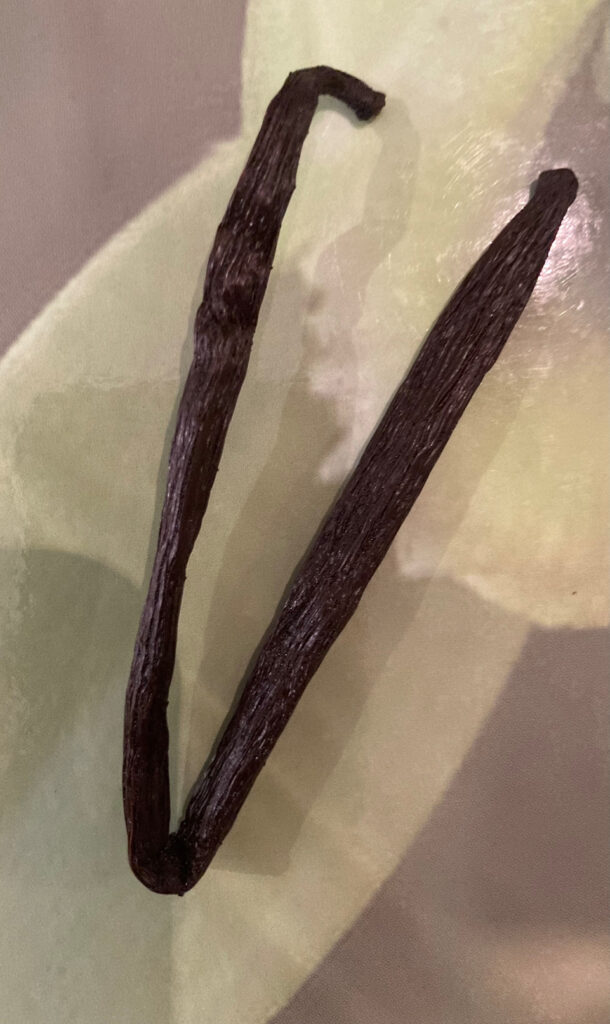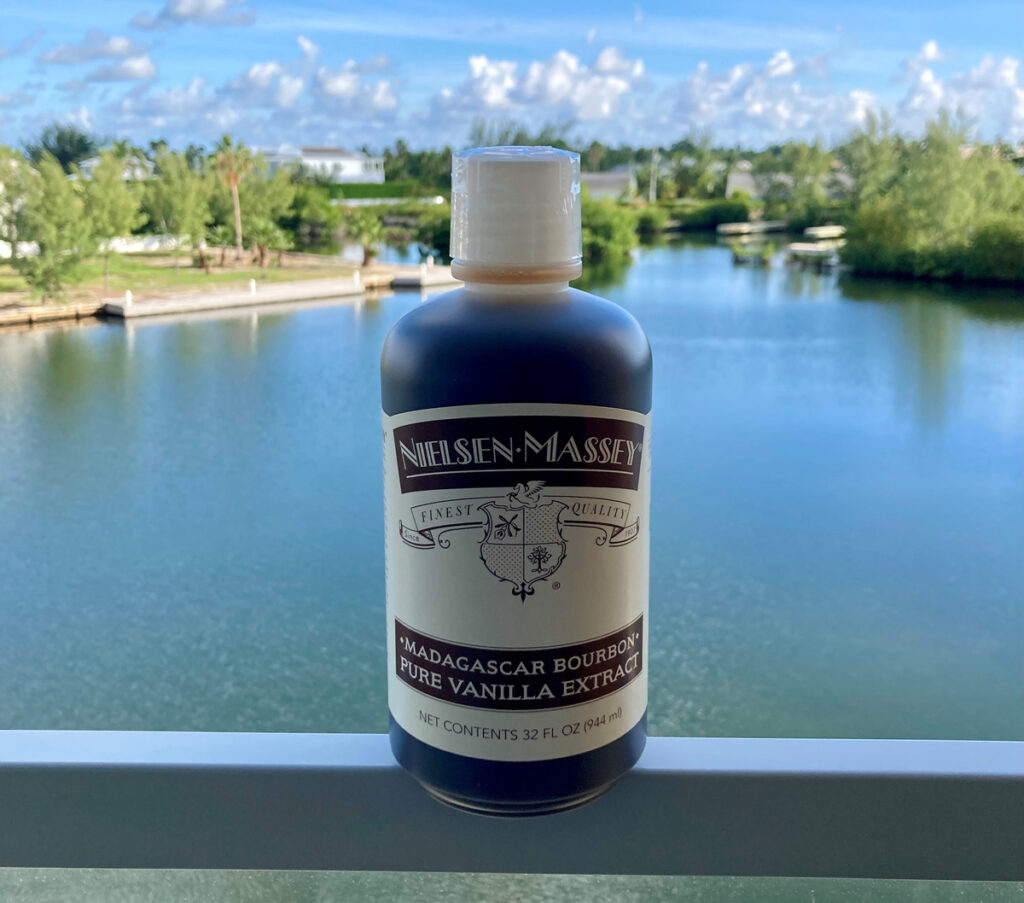by Anne Evans
It’s early November. The Baking Season is upon us (and thank goodness that “Pumpkin Spice Everything” is nearly behind us). I am on my last bottle (and it’s only 4 oz) of my most treasured ingredient – Nielsen Massey® pure vanilla extract. It is indeed the last of what I have left of my stash of vanilla that I imported from the US to Grand Cayman.
I am poised in front of my computer. Do I click “purchase now” and commit to buying this now exorbitantly priced ingredient to initiate its roughly 4–6-week transit to Grand Cayman? An Amazon Prime purchase of a 32oz bottle of Nielsen Massey Madagascar Pure Vanilla Extract (plus US Sales Tax + Overseas Shipping + Cayman Island Import Duty) works out to KY$2.00 [US$2.44] per teaspoon. Should I perhaps reevaluate my less costly options . . . ?
Why is Pure Vanilla so Expensive?
To explain it simply: 1) the harvest of vanilla is a labor-intensive process, and 2) the laws of economics apply, i.e., there is greater demand than supply.
What is Vanilla and What are its Different Forms
Pure Vanilla comes from plants, specifically, a Genus of an Orchid (Vanilla). It is a fleshy, herbaceous climbing perennial vine. There are about 110 species of Vanilla that have been catalogued worldwide. Of those, only 4 types / 3 species are produced commercially: Madagascar & Mexican (both V. planifolia), Tahitian (V. tahitiensi) and occasionally one might run across West Indian (V. pompona).
Madagascar is the most sought after and judged to be the best. Mexican Vanilla is not as available due to a devastating freeze in the late 1950s that destroyed most of the vanilla plants. Tahitian vanilla has a flavor profile that is considerably different from the former 2 – described as being earthy and fruity (ref: Simply Vanilla by Patty Elsberry & Matt Bolus.)
Pure Vanilla Extract
According to the US FDA Code of Code of Federal Regulations CFR – Code of Federal Regulations Title 21 (fda.gov), “Pure Vanilla extract is the solution in aqueous ethyl alcohol of the sapid and odorous principles extractable from vanilla beans. In vanilla extract the content of ethyl alcohol is not less than 35 percent by volume and the content of vanilla constituent, as defined in § 169.3(c), is not less than one unit per gallon.” As a point of reference regarding alcohol content, a glass of wine generally ranges between 11-15 percent alcohol by volume. Hmmm . . . do you feel “buzzed” after eating too many of those high-quality vanilla Shortbread cookies?
Vanilla Beans

Vanilla Beans are actually “pods” that contain tiny seeds. Once harvested, the pods are cured which ultimately results in drying the pods to 25-30% of their original weight to prevent rotting and retain their aroma. In general, a high-quality vanilla bean will have roughly 30% moisture content and be dark brown to black in color with luster and suppleness (Vanilla – Wikipedia). When used for baking, the vanilla bean is cut open by slicing it lengthwise with a sharp paring knife, and then the interior is scraped of its seeds with the latter added to the batter of whatever is being created (example: my White Chocolate Vanilla Cognac Mousse. Recipe follows). The dark brown “specks” of vanilla seeds remain visible in the finished product and speak “I am of Great Quality” given the cost and labor that goes into using Vanilla Beans.
Never through away the pod after it is scraped of its seeds!!! It can be buried in granulated sugar to create ”Vanilla Sugar” or steeped in a liquid such as milk or cognac to eek out the last essence of flavor.
And never make the following mistake either! Many years ago, Rick and I were returning from a vacation from Mexico and wandered through a Duty-Free shop in the airport while waiting to board our plane. Oh, my goodness! – I spied a display of vials of Mexican Vanilla Beans at a ridiculously low price. I cannot recall how many I bought. I can recall that when we returned home, I opened a vial and the 2 beans inside were completely dry, brittle and without aroma. The whole lot was worthless. Lesson learned. Only purchase vanilla beans (or any vanilla product) from a reputable source.
Vanilla Bean Paste
Vanilla Bean Paste is touted as a quality product that offers the convenience of combining high quality pure vanilla extract and the seeds from vanilla beans – without having to scrape the seeds from a vanilla bean pod. That said, it also contains added sugar, water, and a natural thickening agent (Gum Tragacanth). As with the use of vanilla beans, there will be vanilla seeds that remain visible in the finished product (When to Use Vanilla Bean Paste vs Pure Vanilla Extract | Nielsen-Massey Vanillas (nielsenmassey.com).
Recommended uses include ice cream, whipped cream, frostings, puddings, mousse, crème brulee – i.e., where you want to see the specks of vanilla in the finished (sweet) product without having to use a Vanilla Bean.
I don’t generally use Vanilla Bean Paste. I prefer using Pure Vanilla Extract or Vanilla Beans or both used together. I feel this approach enables me to better control the balance of vanilla flavor and sweetness of the final product that I am preparing.
Imitation Vanilla Extract
Ninety-nine percent of the world’s vanilla extract is fake imitation vanilla that’s not a product of the plant itself. Instead, it’s flavored primarily with synthetic vanillin (a lab-produced version of the same chemical compound that occurs naturally in real vanilla). Typically labeled as “vanilla essence,” this artificial vanilla is usually derived from less-than-organic material (like petroleum). While it mimics vanilla’s smell, many would argue that it doesn’t come close to capturing all of the complex floral and woodsy notes that result from the myriad of other flavor compounds in true vanilla. This is why it is considerably less expensive than Pure Vanilla Extract.” (Where Does Vanilla Extract Come From? | Bon Appétit (bonappetit.com)
Enough said other than would I substitute Imitation Vanilla Extract for Pure Vanilla Extract? NEVER!!!
I open my remaining bottle of pure vanilla extract. I take a sniff . . . and think, why would any woman ever wear perfume – when a dab of pure vanilla extract is so much more alluring. I pull the trigger and click on “purchase now”!

Now I have my 32 0z (192 teaspoon) bottle of Pure Vanilla Extract tucked into my pantry and hopefully it will be sufficient to serve my baking needs for the next year.
Check out my White Chocolate Vanilla Cognac Mousse Recipe.

Note this Blog is not sponsored by any of the Brands referenced.

One comment